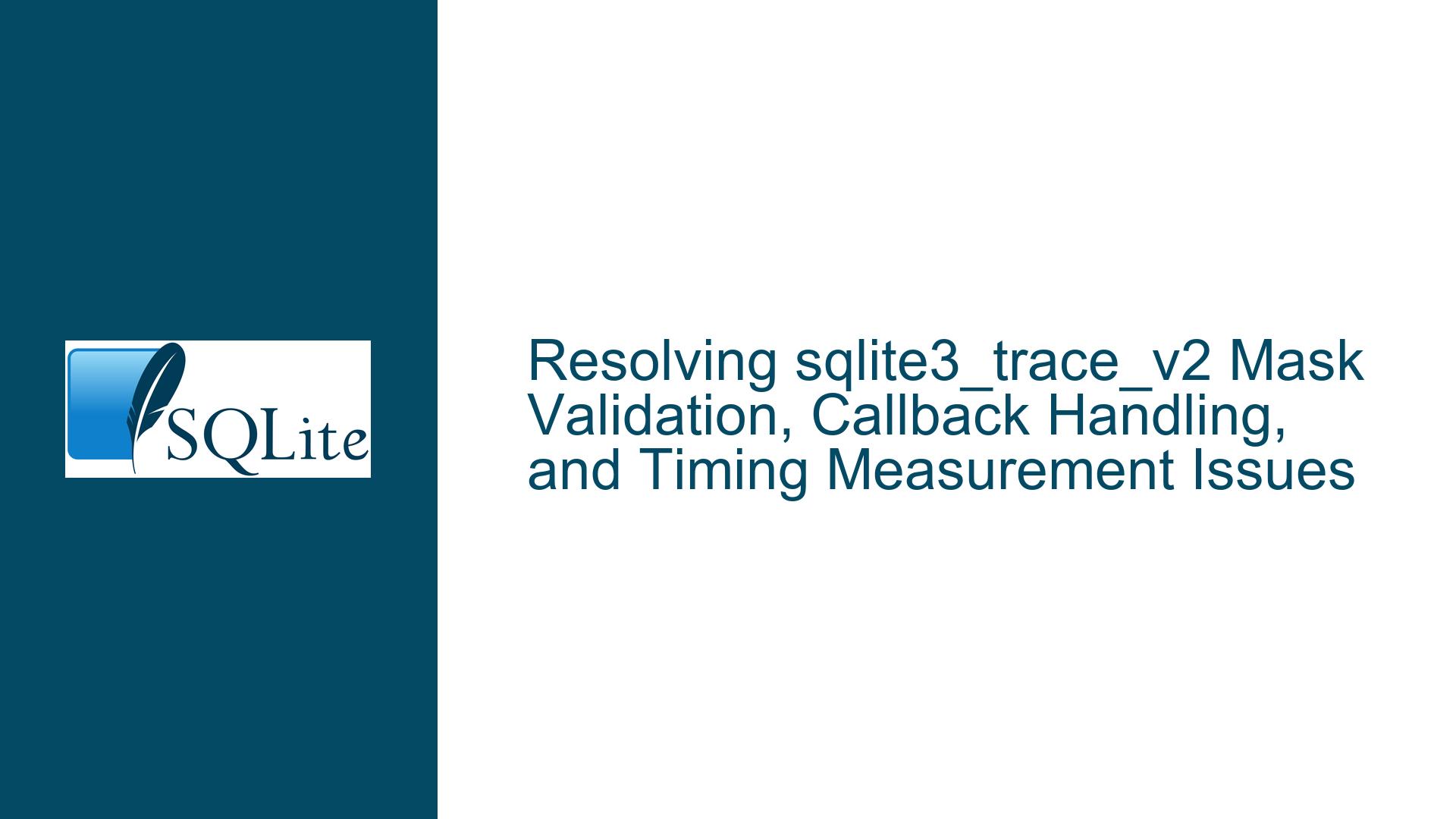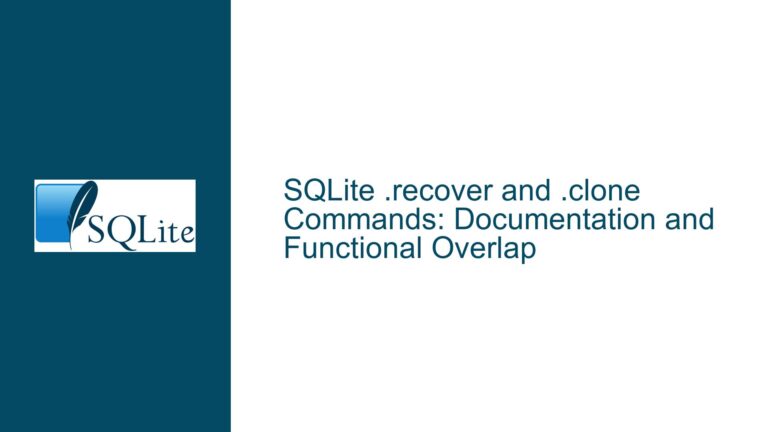Resolving sqlite3_trace_v2 Mask Validation, Callback Handling, and Timing Measurement Issues
Undefined Behavior from Invalid sqlite3_trace_v2 Mask Values and Callback Configuration
The sqlite3_trace_v2 interface allows developers to monitor database operations by registering a callback function triggered during specific events. A critical issue arises when invalid mask values are passed to this function, leading to undefined behavior. The mask parameter must be a bitwise OR of predefined SQLITE_TRACE constants (e.g., SQLITE_TRACE_STMT, SQLITE_TRACE_PROFILE). However, SQLite does not validate whether the provided mask includes undefined or reserved bits. For example, passing 0xff (all bits set) activates internal tracing flags not intended for external use, causing the callback to receive unexpected parameters or malformed data.
This lack of validation violates the principle of failing early for invalid inputs, a practice emphasized in defensive programming. While the SQLITE_MISUSE return code exists to flag API contract violations, sqlite3_trace_v2 does not return this code when invalid masks are used. Instead, it silently processes the request, leaving developers unaware of configuration errors until runtime anomalies occur. This becomes especially problematic in language bindings or middleware layers (e.g., Python modules using the CPython API) where indirect calls to SQLite APIs make debugging harder due to abstraction layers obscuring the root cause.
Another layer of complexity involves the interaction between the mask and callback parameters. The documentation states that passing a NULL callback "disables tracing," but it does not clarify whether this applies globally or per-mask bit. Developers might erroneously assume that setting individual mask bits with a NULL callback selectively disables specific tracing events. In reality, a NULL callback completely disables all tracing regardless of the mask value. This creates ambiguity when attempting to dynamically enable/disable tracing categories at runtime, as there is no mechanism to toggle individual mask bits without re-registering the callback.
Misinterpretation of sqlite3_trace_v2 Timing Measurements Versus sqlite3_profile
The sqlite3_profile function measures the wall-clock time between the first call to sqlite3_step and the subsequent sqlite3_reset or sqlite3_finalize for a prepared statement. This measurement includes all time spent during statement execution, including delays caused by external factors like filesystem I/O, locks, or CPU contention. In contrast, the sqlite3_trace_v2 documentation describes its SQLITE_TRACE_PROFILE event as reporting "the approximate time that the prepared statement took to run," which developers might interpret as measuring only the time spent within SQLite’s internal processing logic.
However, both sqlite3_profile and SQLITE_TRACE_PROFILE ultimately measure wall-clock time, not CPU time or library-exclusive execution time. This discrepancy between developer expectations and actual behavior leads to incorrect performance analyses. For instance, a query appearing slow in profile data might be blamed on SQLite’s query planner or indexing strategy when the delay is actually caused by external resource contention. The lack of nanosecond-precision timing in sqlite3_profile (which uses millisecond resolution) exacerbates this issue, as higher-resolution measurements are essential for microbenchmarking tightly optimized code paths.
The coexistence of sqlite3_profile and sqlite3_trace_v2 introduces additional confusion. Developers might assume these APIs interfere with each other, but they operate independently. This independence allows simultaneous usage but also creates opportunities for conflicting measurements. For example, enabling both APIs could result in overlapping timing data that complicates performance analysis, especially if one callback modifies statement behavior (e.g., introducing delays for logging).
Resolving sqlite3_trace_v2 Configuration Errors and Timing Clarifications
To prevent undefined behavior from invalid masks, enforce strict validation of the mask parameter before invoking sqlite3_trace_v2. Reject any mask containing bits outside the defined SQLITE_TRACE constants. For language bindings, implement wrapper functions that sanitize inputs and convert higher-level abstractions (e.g., enums or bit flags) into valid SQLite constants. For example, in a Python extension, use a bitmask validator that raises a ValueError for unsupported bits, ensuring only valid combinations reach the C layer.
When registering a NULL callback, explicitly set the mask to 0 to avoid ambiguity. This aligns with the documented behavior of disabling tracing entirely. If dynamic toggling of tracing categories is required, maintain a shadow mask in your application layer and only update the sqlite3_trace_v2 configuration when a valid callback is present. For example, use a stateful tracer object that manages the active mask and callback, re-registering them via sqlite3_trace_v2 whenever the configuration changes.
To address timing measurement misunderstandings, instrument both sqlite3_profile and SQLITE_TRACE_PROFILE callbacks while cross-referencing their outputs with external profiling tools. Use platform-specific high-resolution timers (e.g., clock_gettime on Linux or QueryPerformanceCounter on Windows) to capture CPU time or thread-specific execution time. This helps isolate whether delays originate within SQLite or external factors. For nanosecond-precision requirements, supplement SQLite’s profiling data with custom timing logic embedded in trace callbacks.
For long-running queries, correlate trace events with database schema and query plans. Use EXPLAIN to analyze the bytecode generated for a prepared statement and identify potential bottlenecks. Combine this with sqlite3_trace_v2’s SQLITE_TRACE_STMT event to log statement lifecycle phases (prepare, step, reset). Cross-referencing timing data with statement execution phases helps pinpoint whether delays occur during parsing, execution, or cleanup.
To mitigate confusion between wall-clock and CPU time, document the measurement methodology explicitly in your codebase or application logs. Annotate profile outputs with disclaimers about external factors affecting timings. If SQLite-internal timing is critical, consider patching the SQLite source to use CPU-time counters in sqlite3_profile and SQLITE_TRACE_PROFILE, though this approach requires maintaining a custom build and may not be portable across operating systems.
Finally, adopt defensive programming practices for all SQLite API interactions. Validate parameters at abstraction layer boundaries, handle NULL callbacks by resetting the trace configuration, and use compile-time guards like SQLITE_ENABLE_API_ARMOR to enforce stricter parameter checks in debug builds. These steps reduce the risk of runtime errors propagating from misconfigured tracing setups and ensure consistent behavior across direct and indirect API usage.






